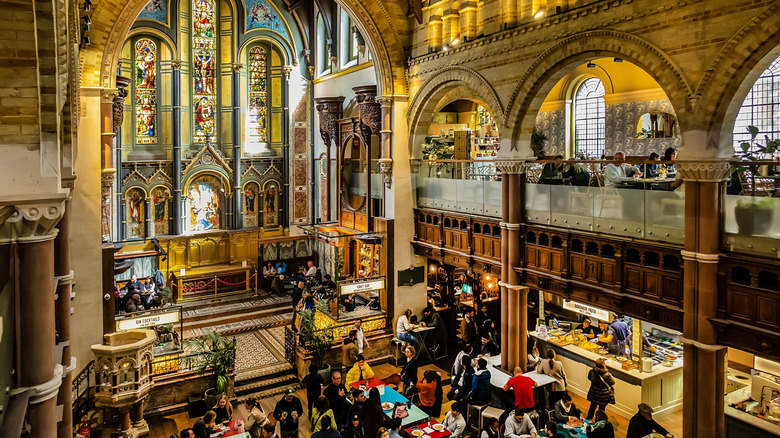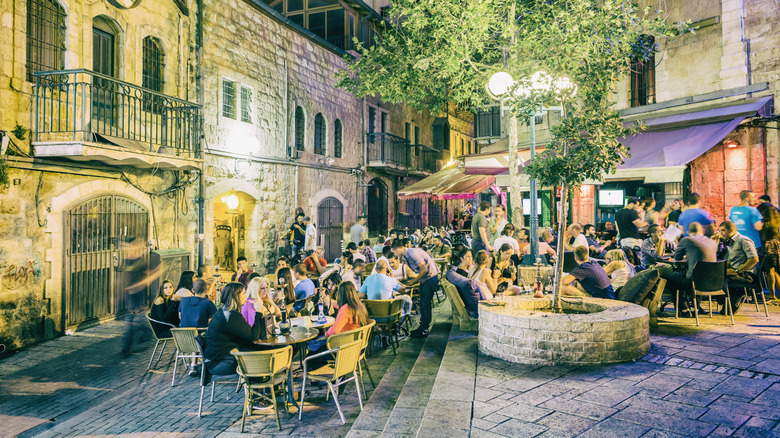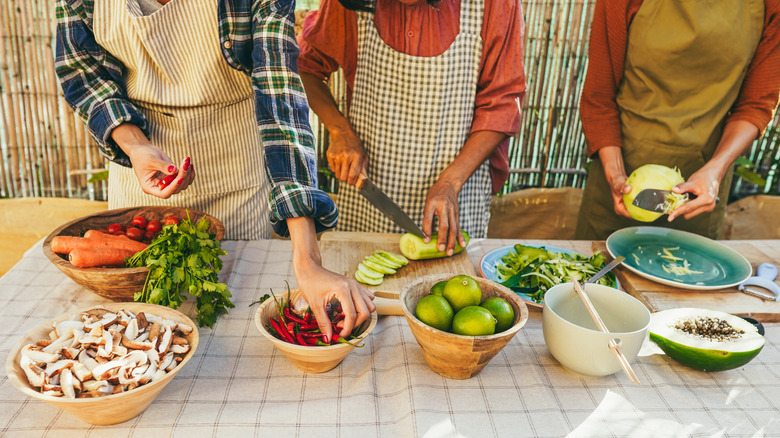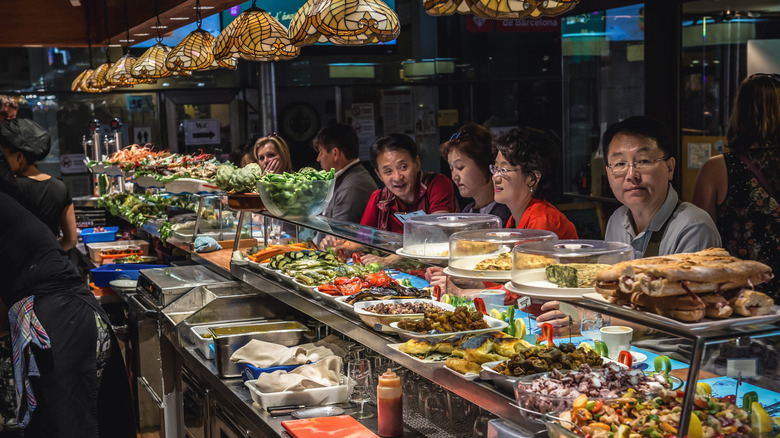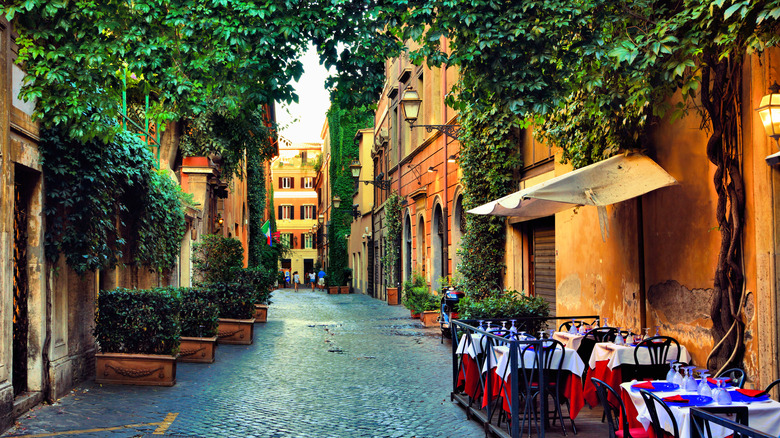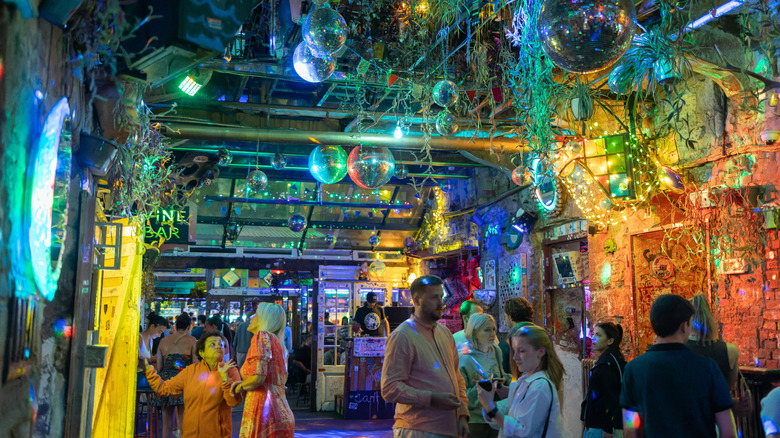11 Ways To Find Unique Places To Eat While On Vacation
Dining out on vacation can be an adventure in itself, especially if you're looking to experience something unique. Maybe you don't want to miss out on once-in-a-lifetime travel experiences like eating in a castle dungeon, or perhaps you'd like to share a meal cooked by locals in their own home, but aren't sure where to start your search. This article will help satisfy your culinary curiosity by showing you how to discover quirky places to eat, wherever you are in the world. From talking to locals and exploring specialist websites to insider tips on using online forums, you'll soon be armed with an arsenal of ideas for finding the best dining experiences while traveling.
Whichever methods you choose, you'll come up with a delicious range of unconventional options for eating out. One moment you could be feasting your eyes on the views from a mountaintop restaurant, and the next, tucking into a meal you've prepared at a cooking class, using ingredients you've never heard of before. As famous chef Gordon Ramsay declares, "eating out is about having fun," which is why it's so crucial to choose spots that stand out from the crowd. If you want a dining experience to write home about, going for something unique is the way forward. Here's how to begin your search and create unforgettable memories.
Ask locals for insider tips on unique places to eat out
When it comes to finding unique dining establishments, there's one group of people that knows best: locals. Whether you're searching for a themed restaurant, a cat café, or simply want to dine somewhere that's a bit different, talking to residents is the way forward. If you're feeling unsure about how to ask locals where to find authentic dining options, just remember to be clear. Inquire where they like to eat to avoid being directed to tourist hot spots they assume you'll enjoy.
Not every eatery has an online presence, but just because it isn't splashed all over Instagram doesn't mean it's not a great place for a meal. By asking locals for their dining recommendations, you'll discover a range of unique options often overlooked by travelers who rely solely on online suggestions. Locals will know where to find the latest pop-up food stalls, quirky breakfast spots, and hidden family-owned joints that have been using the same secret recipes for generations.
A top tip is to ask people who have a vested interest in ensuring you have a good time. Hotel staff are a good place to start, so ask the concierge, bartender, cleaner, and receptionist where they go for a unique meal out. Tour guides and cab drivers are also sound sources of information about top-tier places to eat, as they often know the destination better than anyone.
Use review sites or forums like Tripadvisor, Google Maps, and Yelp
Most people know how to use review sites and map apps to find restaurants. However, if you dive a little deeper, you'll discover a smorgasbord of suggestions for unique places to eat out that are often hard to find in standard results listings. For example, did you know that you can use keywords to search for specific restaurant types in Google Maps?
As well as filtering by cuisine and location, you can use search terms like "historic cafés selling vegan food in London" or "quirky places to eat in New York" to uncover dining options with a difference. It's an easy way to quickly find what you're looking for. The same goes for Yelp, which uses listing information as well as reviews to pull up suggestions to match your search terms.
Meanwhile, platforms like Tripadvisor and Reddit offer a wealth of information on eateries that goes far beyond traditional reviews. On Tripadvisor, bypass the standard listings and head instead to the forums where you'll find threads discussing unusual places to eat in destinations all over the world. Use search terms like "unique restaurant suggestions" to narrow down the selection. On both Tripadvisor and Reddit, if you don't find what you're looking for, you can start a new thread and ask a specific question yourself.
Share a meal in a local home for an intimate dining experience
If you want a truly unique dining experience, skip the tourist restaurants and eat in the home of a local, where your host will cook you a delicious meal and then share it with you. It's a cultural as well as a culinary event, with an authenticity you won't find anywhere else. You'll sit around the kitchen table with your host, chat about the local way of life, and swap stories while you eat — a travel memory that you won't soon forget.
To find social dining opportunities like this, search websites such as eatwith.com, withlocals.com, dinewithalocal.com, and GetYourGuide to see what's available in your destination. Reach out to your chosen host through the platform to discuss a suitable date and menu — don't forget to mention any food allergies. If you'd like to dine with a local but would feel more comfortable in a neutral setting, sites like Viator offer similar experiences in restaurants and inns. You'll still be enjoying a meal with a local resident, but you won't have to go to their home.
The trend of dining in locals' homes is steadily rising as travelers seek unique dining options to enhance their travels. It also helps directly support local economies in a sustainable and mindful way. New friendships are formed through laughter, good food, and companionship, bridging language barriers and cultural differences. It's an extraordinary experience, and likely to be the highlight of your trip.
Join a food walking tour to discover local bars and unique eateries
Food walking tours are a unique way to try authentic dishes at local venues you probably wouldn't come across on your own. You'll gain cultural insights, too, by sharing the experience with a knowledgeable local guide who will tell stories not only about the food but also about the area's history. These immersive tours often take place in lesser-known neighborhoods, so you'll enjoy some unique sightseeing between stops.
The best ways to find food walking tours are to research travel blogs, look for recommendations on Tripadvisor, use websites like Viator, GetYourGuide, secretfoodtours.com, eatingeurope.com, and withlocals.com, or ask the staff at your hotel for suggestions. Try to make sure your tour is led by a local so you know you'll be getting a genuine experience based on personal recommendations. You'll find food walking tours in towns and cities across the world — look for excursions that focus on the unusual rather than the iconic for a truly unique food experience.
In Venice, wander along backwater canals and feast on Venetian tapas in cozy cicchetti bars. Or, in New York, sample delicacies like artichoke pizza, blueberry honey, and pecan pie bonbons off the beaten path. Meanwhile, in London, you can try everything from traditional fish and chips to pork bao buns in quirky settings like historic pubs and family-run Chinatown restaurants. This unique dining experience combines food, culture, history, and sightseeing in one package.
Walk away from popular tourist areas to find authentic restaurants
Cafés and restaurants in tourist hot spots often offer inauthentic, lower-quality, cookie-cutter meals that are more expensive than those at venues farther away. Take, for example, the infamous Greek beach bar in Mykonos that is alleged to overinflate prices, or the tourist-filled cafés that line Piazza Navona in Rome, where the value of the food doesn't reflect the quality of the views. In fact, restaurants that face monuments are usually tourist traps.
To get something a bit different that's far from the crowds, just wander a few blocks from these areas, and you'll discover unique dining options for a more authentic experience and at a fraction of the price. Residential neighborhoods are good places to search, as this is where the locals eat, with family-run restaurants and independent boutique cafés tucked away down leafy side streets.
The best way to find these unique dining spots is to use Google Maps while you walk, to see what's around the corner. You can do a review check before going in, either on Google or Tripadvisor, but if you see long queues, that's a strong indication the food will be good. Note that many of these less conspicuous eateries don't have a social media presence, and that's not a bad thing. They're just concentrating on cooking up the goods rather than posting pretty photos online.
Look for a cooking class and discover local food stories
Combining cooking and eating is a fun way to discover local cuisine, especially when you have an expert chef on hand to guide you through the process. In special cooking classes, you'll learn about the culinary traditions of your destination and create dishes that tell a story, which makes them taste even better. Plus, it's a great way to meet fellow travelers and pick up some new recipes to bring back home with you.
To find the most unique cooking classes, look at restaurant websites to see which establishments offer workshops, and check the local tourist board for suggestions too. Another top tip is to look at hotel websites, especially if you're visiting a destination known for its cuisine, because some properties offer cooking classes to non-guests. Fellow travelers are also a good source of information, so do ask for recommendations from people who have done it before.
Consider the type of cuisine you fancy cooking to help refine your search. Are you looking for the iconic or the extraordinary? For example, you can get hands-on making homemade pasta in Tuscany, experiment with unusual yet delicious ingredients like buffalo bile in Luang Prabang, or learn how to cook a tagine in under an hour in Marrakech. Not only will you come away with a full belly and cherished memories, but you may also be gifted a souvenir to remember your experience. Aprons, cookware, and recipe books are popular choices.
Find social enterprise food ventures for community-led cuisine
For a unique dining experience that makes a real difference, search for non-profit or social enterprise organizations that run restaurants and cafés in your destination. These places often serve traditional dishes prepared by trainee chefs with disadvantaged backgrounds, so this is a chance to give back on your travels as well as meet locals and enjoy a tasty meal.
A good place to find information about these special restaurant and café ventures is on local charity websites or in person at their city stores. Otherwise, a quick online search for "social enterprise restaurants" will point you in the right direction. Hotel workers can be a good source of information, too, and it's worth asking staff at other restaurants, since they'll have their ears to the ground for local foodie experiences.
An example of a social enterprise dining experience is the Amal restaurant in Marrakech, which empowers vulnerable local women through a cooking training program. Here, you'll be eating delicious meals like couscous and lemon chicken prepared by the ladies, while learning their stories and helping them work towards independence. Meanwhile, Vancouver's Social Crust Café supports young adults facing mental health challenges and employment barriers while serving up cheese muffins, salad bowls, and toasted sandwiches to hungry travelers looking for a lunch with a difference.
Wander around food markets and food halls to sample unique dishes
If you're craving something different and want to try some unusual local flavors, then markets, food halls, bazaars, and hawker centers are great places to explore with a rumbling stomach. Many of these spots have dedicated dining areas with stalls serving delicious local dishes made with produce straight from the market — cooked right before your eyes, so you know it's fresh.
Market and hawker center locations are usually easy to find, but once you're there, it can be overwhelming trying to decide which food stalls to try. Whether you're experiencing sensory overload at La Boqueria in Barcelona or exploring the Singapore-style food hall in New York City, it can all feel a bit much. Yet by keeping the following points in mind, you'll soon be devouring tasty morsels from the most unique food stalls.
Eat where the locals eat, as they'll know where to find the most authentic food at the best prices. These spots probably have higher hygiene standards, too. Avoid stalls that are crowded with tourists, as these are likely to serve inferior meals at inflated rates. Follow your nose — the food that smells the best is usually the tastiest. Finally, look at blogs on local hotel sites for insider recommendations, or read press articles for updates on unique new restaurant openings and reviews.
Search for exclusive dining venues that are hard to access
For the ultimate unique dining experience, look for restaurants that are difficult to get into, thanks to either geographical barriers or reputation-led popularity. Sought-after venues like these are rare, which makes them even more special. Use your favorite search engine to find restaurants with long waiting lists, where only a select few diners who have planned their outing well in advance get to eat.
The famous Fat Duck in England's Berkshire receives 30,000 reservations calls a day, while the House of Prime Rib is the hardest steakhouse to get into in San Francisco, where reservations up to a year in advance are advised. These are solid indications that dining there will be a unique experience. To increase your chances of getting a table at such restaurants, avoid peak dining times (choose a mid-afternoon slot instead) and go mid-week rather than at the weekend. It's worth checking for last-minute cancellations too, so flexibility is key.
Even more unique are restaurants that are physically hard to reach, which will mean fewer people make the effort to get there. Search for "remote restaurants" in your destination to see what's around. If you're in a mountainous region like the French Alps, check if there's a café at one of the upper cable car stations, or if you're coastal, look for island restaurants, like the Rock Restaurant in Zanzibar, which can only be reached by boat or by wading through the sea at low tide.
Use social media and local food blogs to find unusual places to eat out
Social media platforms like Instagram, Facebook, Pinterest, and TikTok can be a fun, quick, and visual way to find unique places to eat in your chosen destination. Just type in your search or use hashtags like #uniquerestaurantsparis and get scrolling. Try to be as specific as possible in your searches to find what you're looking for. YouTube can be a great resource, too, with vloggers documenting their dining experiences and offering in-depth reviews of venues.
When reviewing your search results, be mindful of paid influencer and media partnerships that could bias the review. Focus instead on travelers and locals posting about their own independent experiences. Once you've chosen some contenders, back up this research by looking at reviews on Tripadvisor or OpenTable.
Food blogs are another great way to discover quirky dining options. As American chef and author Anthony Bourdain once declared to Shermans Travel, "Food bloggers are a great resource because they've gotten to know and cover one aspect of the culture." Search for blogs written by residents rather than travelers who have just visited for a couple of days, to ensure you're getting real insider tips. You can check out travel blogs, too, as many document culinary experiences and often showcase extraordinary places to eat out.
Search for unique restaurants according to the environment you're in
For one-of-a-kind eating experiences, search for restaurants unique to the environment that you're in. For example, in volcanic regions like the Canary Islands, geothermal heat is used for cooking in restaurants like El Diablo in Lanzarote. Meanwhile, in the Maldives, some islands offer underwater dining so you can watch tropical fish while you eat, like at the Ithaa Undersea Restaurant on Rangali Island.
One of the easiest ways to find unique location-themed eateries is to check with the local tourism board, since these will be among the region's most iconic restaurants. Travel blogs can be helpful, too, if you do a super-specific search for "quirky places to eat" in your destination (if you're in New York, this unique high-tech AI fine dining restaurant might come up in your query).
If you're visiting a city in Europe, wander through the historic center and look for restaurant signs outside old buildings; many have been converted into unique eating spaces. You'll come across everything from Gothic basement dining in Prague and medieval taverns in Munich, to dungeon restaurants in Edinburgh, and London cafés in church crypts. Former industrial neighborhoods are also good places to find unusual restaurants with an edgy vibe. The ruin bars of Budapest are a prime example, where abandoned buildings have been decked out with second-hand furniture and mood lighting to create eclectic entertainment spaces.
